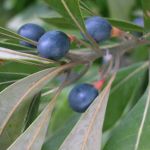| Common Name: |
Tisswood |
| Other Names: |
Red Bay |
| Botanical Name: |
Persea borbonia |
| Genus: |
Persea |
| Family: |
Lauraceae |
| Native Location: |
SE USA |
| Cultivation: |
Well-drained, medium loam, pH5.5-6.5, in full sun, between 20-28°C (68-82°F), with humidity above 60 percent (avocados); some Mexican and Guatemalan cultivars withstand low temperatures but do not usually flower or fruit well as a result. Avocados are prone to root rot, fungal leaf spot and, under glass, to whiteflies, spider mites, and mealybugs. Rich, moist, slightly acidic soil in sun or partial shade (P. borbonia). |
| Propagation: |
By seed sown when ripe in sandy soil mix, with upper half above surface, at 20-28°C (68-82°F) (avocado). Soak seed in hot water for 30 minutes, then cut off 1cm (3/8in) from tip of seed, before sowing. By seed sown when ripe, chilled for 7 days before sowing (P. borbonia). |
| Harvest: |
Fruits are picked when ripe and used fresh or pressed for oil. Leaves are collected during the growing season and dried for infusions. Bark is removed from young branches after pruning for use in decoctions. |
| Height: |
10-12m (30-40ft) |
| :Width |
5m (15ft) |
| Hardiness: |
Min. 10°C (50°F) |
| Parts Used: |
Leaves |
| Properties: |
An aromatic herb with insect repellent effects. Leaves have an aroma similar to bay (Laurus nobilis) but more camphoraceous. |
| Culinary Uses: |
Fresh or dried leaves are used to flavor Creole dishes, and as a substitute for bay leaves; also infused for tea. |
| Economic Uses: |
Foliage is used to repel insects from dried foods in pantries and cupboards. |
| Bibliography: |
The Encyclopedia of Herbs by Deni Bown Copyright © 1995, 2001 Dorling Kindersley Limited. pp 308-309
|

